Introduction to CSS Borders - Lesson 4
Download as PPT, PDF2 likes944 views
The border CSS property is a shorthand property for setting the individual border property values in a single place in the style sheet. border can be used to set the values for one or more of: border-width , border-style , border-color .
1 of 10
Downloaded 17 times


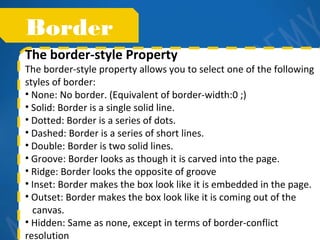



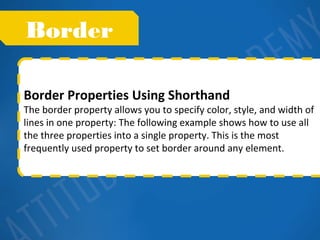



Recommended
CSS Basics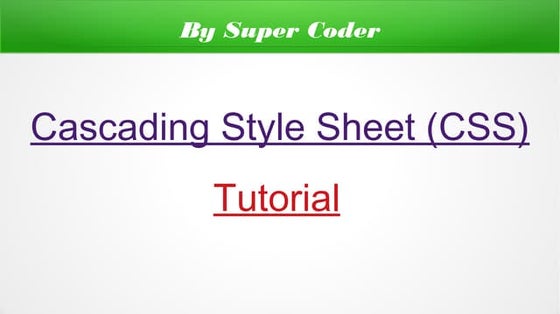



CSS BasicsSanjeev Kumar
╠²
CSS Tutorial | CSS Basics For Beginners | Css Box Model | CSS Text | CSS Font | CSS HTML | CSS StylingCss tables



Css tablesAbhishekMondal42
╠²
This document summarizes various CSS properties that can be used to style HTML tables. It describes properties such as border-collapse, border-spacing, caption-side, empty-cells, and table-layout that control the appearance and layout of table borders, cell spacing, caption placement, empty cell styling, and layout algorithm respectively. Examples are provided to demonstrate the effects of each property.CSS - Text Properties



CSS - Text Propertieshstryk
╠²
This document summarizes various CSS text properties including color, font-weight and style, font-family, letter-spacing, text-align, text-decoration, text-transform, line-height, and word-spacing. It provides possible values and examples for setting each property to control text styling and formatting.Css pseudo-classes



Css pseudo-classesWebtech Learning
╠²
Pseudo-classes are used to define special states of CSS elements. They allow styling elements when a user mouses over, focuses on, visits, or activates them. Common pseudo-classes include :hover, :focus, :visited, and :active. Pseudo-classes can be used with CSS classes and selectors like :first-child to style specific elements, such as styling the first <p> element or changing the color of a link on hover. Pseudo-elements like ::before and ::after allow inserting content before or after elements.Flexbox



FlexboxNetcetera
╠²
Introduction and real-life examples about using Flexbox. Presented at the front-end meetup in Skopje on 12.01.2016.Html5 semantics



Html5 semanticsWebtech Learning
╠²
The document discusses HTML5 semantic and non-semantic elements. It defines semantic elements as those with inherent meaning, like <form> and <table>, while non-semantic elements like <div> and <span> do not convey meaning. New HTML5 semantic elements are introduced, including <section> for sections, <article> for independent content, <header> and <footer> for introductory and footer content, and <nav> for navigation links. Semantic elements are important for search engines and accessibility by clearly defining the meaning of different parts of a web page.Jquery



JqueryGirish Srivastava
╠²
This document provides an introduction to jQuery, covering its features, comparisons to other frameworks, selectors, and plugins. jQuery is an open-source JavaScript library that simplifies DOM manipulation, event handling, animations, and Ajax interactions. It uses CSS-style selectors to select and manipulate HTML elements. Some key features include DOM element selections, DOM traversal/modification, DOM manipulation based on CSS selectors, events, effects/animations, Ajax, and extensibility through plugins. The document also discusses jQuery versus other frameworks like Dojo and YUI, demonstrates basic selectors and methods, and encourages the use of plugins to add additional functionality.Java script



Java scriptAbhishek Kesharwani
╠²
JavaScript was designed to add interactivity to HTML pages. It is a scripting language that is usually embedded directly into HTML pages and allows for dynamic text, event handling, reading/writing HTML elements, and validating form data. JavaScript supports both client-side and server-side scripting and was originally developed by Netscape under the name LiveScript before being renamed. It provides programming capabilities to HTML authors and allows for dynamic content, user interaction, and validation without server requests.Flex box



Flex boxHarish Karthick
╠²
This complete guide explains everything about flexbox, focusing on all the different possible properties for the parent element (the flex container) and the child elements (the flex items).Introduction to css & its attributes with syntax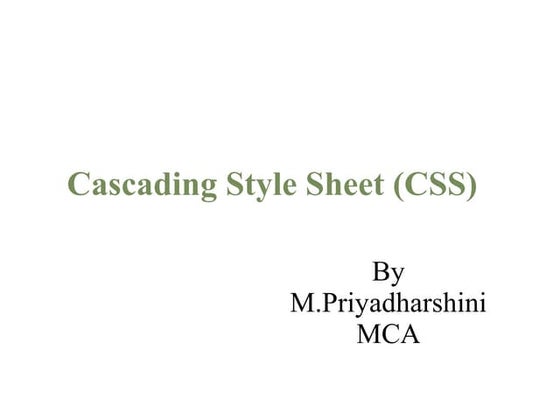



Introduction to css & its attributes with syntaxpriyadharshini murugan
╠²
only an introduction to cascading style sheet (CSS) &I its attributes with syntax and general examplesHow Cascading Style Sheets (CSS) Works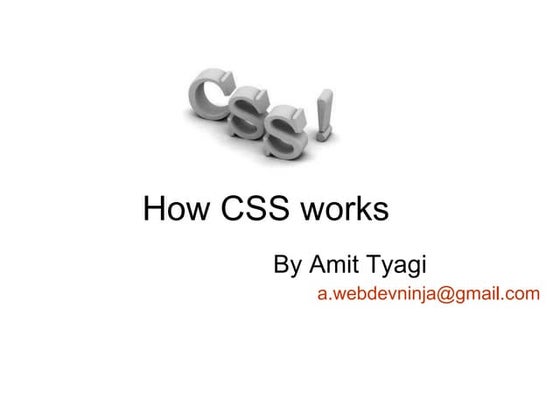



How Cascading Style Sheets (CSS) WorksAmit Tyagi
╠²
CSS (Cascading Style Sheets) allows separation of document content from page layout/presentation. CSS was introduced to make web page design and modification easier. CSS properties control elements like text formatting, page layout, and color/images. CSS rules cascade from broad to specific with author styles overriding browser defaults. Common selectors target elements by ID, class, tag name or relationship.Css backgrounds



Css backgroundsAbhishekMondal42
╠²
This document discusses CSS background properties. It explains how to set the background color, image, repeat, position, and attachment. Examples are provided to demonstrate setting the background color to yellow, repeating an image vertically and horizontally, positioning an image 100px from the left and 200px from the top, and fixing a background image to remain stationary while scrolling.Cascading Style Sheets (CSS) help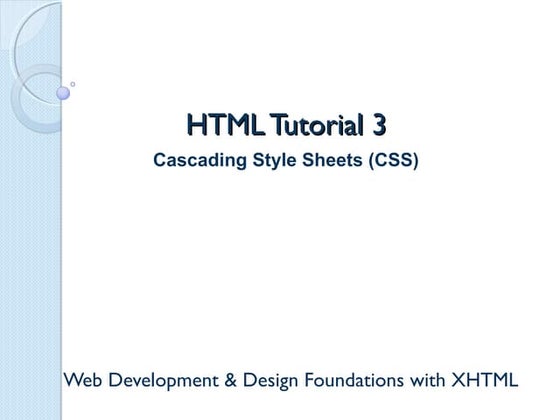



Cascading Style Sheets (CSS) helpcasestudyhelp
╠²
CSS╠²stands for╠²Cascading╠²Style╠²Sheets
Styles define╠²how to display╠²HTML elements
External Style Sheets╠²can save a lot of work
Styles are normally saved in external .css files. External style sheets enable you to change the appearance and layout of all the pages in a Web site, just by editing one single file!Css



CssHemant Saini
╠²
this presentation covers the following topics which are as follows
1. Introduction of css
2. History of css
3. Types of css styling
4. Css syntax
5. Css Selector
6. Css Variations Or Css VersionsCSS Lists and Tables



CSS Lists and TablesGerson Abesamis
╠²
The document discusses various CSS techniques for styling lists and tables. It provides examples of how to change list item markers, add images as markers, and control marker positioning. For tables, it shows how to add borders to tables and cells, control border styles, widths and colors, and collapse cell borders. Styles are demonstrated for centering, padding and aligning table cell content as well as setting background colors and text colors.CSS Day: CSS Grid Layout 



CSS Day: CSS Grid Layout Rachel Andrew
╠²
This document summarizes CSS Grid Layout, a new two-dimensional grid system being added to CSS. It discusses some of the limitations of existing CSS layout methods and how Grid Layout addresses them. Key points include: Grid Layout uses line-based placement to position items, grid tracks can be flexible or fixed widths, areas can be explicitly or implicitly named, and the system avoids hacks and limitations of previous methods.Css Ppt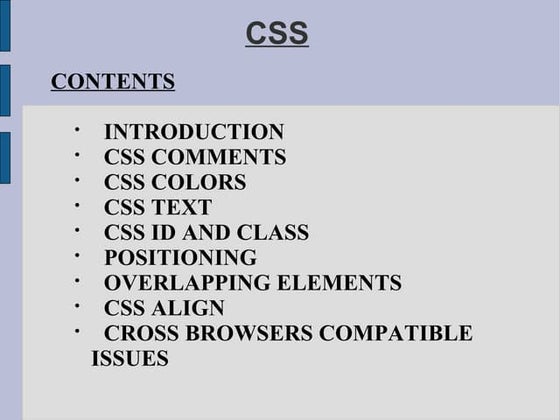



Css PptHema Prasanth
╠²
This document provides an overview of various CSS topics including comments, colors, text formatting, positioning, and cross-browser compatibility. It explains concepts like using hexadecimal color codes, text properties like alignment and decoration, positioning elements with static, relative, absolute and fixed positioning, and strategies for aligning elements and dealing with browser inconsistencies.HTML Semantic Tags



HTML Semantic TagsBruce Kyle
╠²
This 20-minute presentation provides an introduction to several HTML5 semantic tags: article, section, aside, header, footer, nav. Includes how you can address browser compatibility issues.Css Text Formatting



Css Text FormattingDr. Jasmine Beulah Gnanadurai
╠²
This document discusses CSS text formatting properties including text color, alignment, decoration, transformation, indentation, letter spacing, and line height. It provides examples of how each property can be used by specifying the property name and value in a CSS style rule. For example, to center align text the text-align property is set to center. Various text formatting properties allow control over text color, positioning, effects, spacing, and other visual aspects through CSS.Introduction to Cascading Style Sheets (CSS)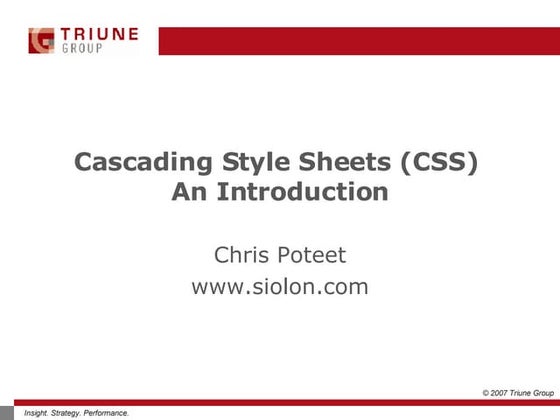



Introduction to Cascading Style Sheets (CSS)Chris Poteet
╠²
This document provides an introduction to Cascading Style Sheets (CSS) including definitions, why CSS is used, the cascade, inheritance, using style sheets, CSS syntax, selectors, the box model, CSS and the semantic web, browser acceptance, fonts, units, colors, layouts, text formatting, backgrounds, lists, shorthand properties, accessibility, and resources for further information.CSS Layouting #2 : Dimensi & Overflow



CSS Layouting #2 : Dimensi & OverflowSandhika Galih
╠²
Ada 2 property pada CSS yang digunakan untuk mengatur Dimensi pada elemen HTML kita, property-nya yaitu width dan height.
Pada video ini, kita akan bahas bagaimana cara menggunakan property tersebut, dan juga unit / satuan apa saja yang dapat kita gunakan untuk mengatur width dan height-nya.
Di video ini juga akan dibahas mengenai overflow, yaitu property CSS yang digunakan untuk mengatur perilaku sebuah elemen, ketika isi / konten nya melebihi tempat / parent nya.
slide bantuan untuk video youtube:
https://youtu.be/VkUSH3SIH0gCSS Positioning Elements.pdf



CSS Positioning Elements.pdfKongu Engineering College, Perundurai, Erode
╠²
This document discusses different CSS positioning methods including fixed, absolute, relative, static, and sticky positioning. It provides code examples to demonstrate how each positioning method works. Fixed positioning positions an element relative to the browser window, absolute positioning positions elements relative to the screen, relative positioning positions elements relative to their normal position, and static positioning is the default that positions elements in normal flow without affecting positioning properties. Sticky positioning positions elements based on the user's scroll position.Css position



Css positionWebtech Learning
╠²
The document discusses the CSS position property, which specifies the type of positioning for an element. There are four position values - static, relative, fixed, and absolute. Elements are then positioned using top, bottom, left, and right properties. These positioning properties work differently depending on the position value. The document provides examples and explanations of each position value.Css



Cssshanmuga rajan
╠²
This document provides an overview of Cascading Style Sheets (CSS) including:
- CSS handles the look and feel of web pages by controlling colors, fonts, spacing, layouts, backgrounds and more.
- CSS versions include CSS1 for basic formatting, CSS2 for media styles and positioning, and CSS3 for new features like colors and transforms.
- There are three ways to apply stylesheets: inline with HTML tags, internally within <style> tags, and externally with <link> tags.
- The Style Builder in Microsoft allows applying styles through a dialog box with options for fonts, backgrounds, text, positioning, and other properties. Basic CSS syntax uses selectors and properties toCSS Dasar #5 : Text Styling



CSS Dasar #5 : Text StylingSandhika Galih
╠²
Setelah di slide sebelumnya kita mempelajari tentang bagaimana memberi style pada font, di slide kali ini yang akan kita bahas adalah memberikan style pada text seperti pengaturan paragraf, pengaturan warna, dll
slide bantuan untuk video youtube:
https://youtu.be/xih8giA7S3QCss borders



Css bordersAbhishekMondal42
╠²
The document discusses CSS border properties, including border-color, border-style, and border-width. It explains that these properties allow customizing an element's border by specifying color, style (such as solid, dotted, dashed), and width. It provides examples of using individual properties to style each border side separately, as well as using shorthand border property to style all sides at once.Html introduction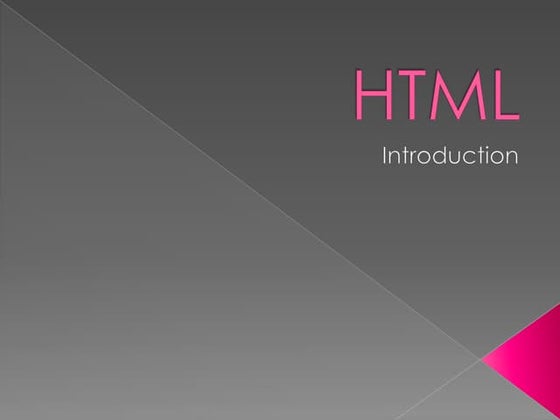



Html introductionDalia Elbadry
╠²
HTML is a markup language used to define the structure and layout of web pages. HTML uses tags to annotate text, images, and other content for display in a web browser. Some key HTML tags include <h1> for main headings, <p> for paragraphs, <a> for links, <img> for images, <ul> and <ol> for unordered and ordered lists. CSS can be used to style and lay out HTML elements.CSS Positioning and Features of CSS3



CSS Positioning and Features of CSS3Jaimin Brahmbhatt
╠²
CSS Positioning
The position property specifies the type of positioning method used for an element.
There are five different position values:
ŌĆóstatic
ŌĆórelative
ŌĆófixed
ŌĆóabsolute
ŌĆósticky
CSS3 Features
ŌĆóCSS Animations and Transitions
ŌĆóCalculating Values With calc()
ŌĆóAdvanced Selectors
ŌĆóGenerated Content and Counters
ŌĆóGradients
ŌĆóWebfonts
ŌĆóBox Sizing
ŌĆóBorder Images
ŌĆóMedia Queries
ŌĆóMultiple Backgrounds
ŌĆóCSS Columns
ŌĆóCSS 3D Transforms
Download PPT with Examples up here - https://goo.gl/k4cyfo
Border



BorderAnkit Dubey
╠²
The document discusses CSS border properties. It describes how to specify border styles (e.g. solid, dotted), widths, and colors. Shorthand properties allow setting multiple border properties at once, such as border style for all sides or just one side. Rounded borders can be added using the border-radius property.CSS tutorial chapter 2



CSS tutorial chapter 2jeweltutin
╠²
The Cascading Style Sheets Specification ( CSS ) is a computer language that is used to write formatting instructions ( rules ). These rules tell a web browser how webpage content should 'look'ŌĆö in terms of: layout. position, alignment, width, height, etc.More Related Content
What's hot (20)
Flex box



Flex boxHarish Karthick
╠²
This complete guide explains everything about flexbox, focusing on all the different possible properties for the parent element (the flex container) and the child elements (the flex items).Introduction to css & its attributes with syntax



Introduction to css & its attributes with syntaxpriyadharshini murugan
╠²
only an introduction to cascading style sheet (CSS) &I its attributes with syntax and general examplesHow Cascading Style Sheets (CSS) Works



How Cascading Style Sheets (CSS) WorksAmit Tyagi
╠²
CSS (Cascading Style Sheets) allows separation of document content from page layout/presentation. CSS was introduced to make web page design and modification easier. CSS properties control elements like text formatting, page layout, and color/images. CSS rules cascade from broad to specific with author styles overriding browser defaults. Common selectors target elements by ID, class, tag name or relationship.Css backgrounds



Css backgroundsAbhishekMondal42
╠²
This document discusses CSS background properties. It explains how to set the background color, image, repeat, position, and attachment. Examples are provided to demonstrate setting the background color to yellow, repeating an image vertically and horizontally, positioning an image 100px from the left and 200px from the top, and fixing a background image to remain stationary while scrolling.Cascading Style Sheets (CSS) help



Cascading Style Sheets (CSS) helpcasestudyhelp
╠²
CSS╠²stands for╠²Cascading╠²Style╠²Sheets
Styles define╠²how to display╠²HTML elements
External Style Sheets╠²can save a lot of work
Styles are normally saved in external .css files. External style sheets enable you to change the appearance and layout of all the pages in a Web site, just by editing one single file!Css



CssHemant Saini
╠²
this presentation covers the following topics which are as follows
1. Introduction of css
2. History of css
3. Types of css styling
4. Css syntax
5. Css Selector
6. Css Variations Or Css VersionsCSS Lists and Tables



CSS Lists and TablesGerson Abesamis
╠²
The document discusses various CSS techniques for styling lists and tables. It provides examples of how to change list item markers, add images as markers, and control marker positioning. For tables, it shows how to add borders to tables and cells, control border styles, widths and colors, and collapse cell borders. Styles are demonstrated for centering, padding and aligning table cell content as well as setting background colors and text colors.CSS Day: CSS Grid Layout 



CSS Day: CSS Grid Layout Rachel Andrew
╠²
This document summarizes CSS Grid Layout, a new two-dimensional grid system being added to CSS. It discusses some of the limitations of existing CSS layout methods and how Grid Layout addresses them. Key points include: Grid Layout uses line-based placement to position items, grid tracks can be flexible or fixed widths, areas can be explicitly or implicitly named, and the system avoids hacks and limitations of previous methods.Css Ppt



Css PptHema Prasanth
╠²
This document provides an overview of various CSS topics including comments, colors, text formatting, positioning, and cross-browser compatibility. It explains concepts like using hexadecimal color codes, text properties like alignment and decoration, positioning elements with static, relative, absolute and fixed positioning, and strategies for aligning elements and dealing with browser inconsistencies.HTML Semantic Tags



HTML Semantic TagsBruce Kyle
╠²
This 20-minute presentation provides an introduction to several HTML5 semantic tags: article, section, aside, header, footer, nav. Includes how you can address browser compatibility issues.Css Text Formatting



Css Text FormattingDr. Jasmine Beulah Gnanadurai
╠²
This document discusses CSS text formatting properties including text color, alignment, decoration, transformation, indentation, letter spacing, and line height. It provides examples of how each property can be used by specifying the property name and value in a CSS style rule. For example, to center align text the text-align property is set to center. Various text formatting properties allow control over text color, positioning, effects, spacing, and other visual aspects through CSS.Introduction to Cascading Style Sheets (CSS)



Introduction to Cascading Style Sheets (CSS)Chris Poteet
╠²
This document provides an introduction to Cascading Style Sheets (CSS) including definitions, why CSS is used, the cascade, inheritance, using style sheets, CSS syntax, selectors, the box model, CSS and the semantic web, browser acceptance, fonts, units, colors, layouts, text formatting, backgrounds, lists, shorthand properties, accessibility, and resources for further information.CSS Layouting #2 : Dimensi & Overflow



CSS Layouting #2 : Dimensi & OverflowSandhika Galih
╠²
Ada 2 property pada CSS yang digunakan untuk mengatur Dimensi pada elemen HTML kita, property-nya yaitu width dan height.
Pada video ini, kita akan bahas bagaimana cara menggunakan property tersebut, dan juga unit / satuan apa saja yang dapat kita gunakan untuk mengatur width dan height-nya.
Di video ini juga akan dibahas mengenai overflow, yaitu property CSS yang digunakan untuk mengatur perilaku sebuah elemen, ketika isi / konten nya melebihi tempat / parent nya.
slide bantuan untuk video youtube:
https://youtu.be/VkUSH3SIH0gCSS Positioning Elements.pdf



CSS Positioning Elements.pdfKongu Engineering College, Perundurai, Erode
╠²
This document discusses different CSS positioning methods including fixed, absolute, relative, static, and sticky positioning. It provides code examples to demonstrate how each positioning method works. Fixed positioning positions an element relative to the browser window, absolute positioning positions elements relative to the screen, relative positioning positions elements relative to their normal position, and static positioning is the default that positions elements in normal flow without affecting positioning properties. Sticky positioning positions elements based on the user's scroll position.Css position



Css positionWebtech Learning
╠²
The document discusses the CSS position property, which specifies the type of positioning for an element. There are four position values - static, relative, fixed, and absolute. Elements are then positioned using top, bottom, left, and right properties. These positioning properties work differently depending on the position value. The document provides examples and explanations of each position value.Css



Cssshanmuga rajan
╠²
This document provides an overview of Cascading Style Sheets (CSS) including:
- CSS handles the look and feel of web pages by controlling colors, fonts, spacing, layouts, backgrounds and more.
- CSS versions include CSS1 for basic formatting, CSS2 for media styles and positioning, and CSS3 for new features like colors and transforms.
- There are three ways to apply stylesheets: inline with HTML tags, internally within <style> tags, and externally with <link> tags.
- The Style Builder in Microsoft allows applying styles through a dialog box with options for fonts, backgrounds, text, positioning, and other properties. Basic CSS syntax uses selectors and properties toCSS Dasar #5 : Text Styling



CSS Dasar #5 : Text StylingSandhika Galih
╠²
Setelah di slide sebelumnya kita mempelajari tentang bagaimana memberi style pada font, di slide kali ini yang akan kita bahas adalah memberikan style pada text seperti pengaturan paragraf, pengaturan warna, dll
slide bantuan untuk video youtube:
https://youtu.be/xih8giA7S3QCss borders



Css bordersAbhishekMondal42
╠²
The document discusses CSS border properties, including border-color, border-style, and border-width. It explains that these properties allow customizing an element's border by specifying color, style (such as solid, dotted, dashed), and width. It provides examples of using individual properties to style each border side separately, as well as using shorthand border property to style all sides at once.Html introduction



Html introductionDalia Elbadry
╠²
HTML is a markup language used to define the structure and layout of web pages. HTML uses tags to annotate text, images, and other content for display in a web browser. Some key HTML tags include <h1> for main headings, <p> for paragraphs, <a> for links, <img> for images, <ul> and <ol> for unordered and ordered lists. CSS can be used to style and lay out HTML elements.CSS Positioning and Features of CSS3



CSS Positioning and Features of CSS3Jaimin Brahmbhatt
╠²
CSS Positioning
The position property specifies the type of positioning method used for an element.
There are five different position values:
ŌĆóstatic
ŌĆórelative
ŌĆófixed
ŌĆóabsolute
ŌĆósticky
CSS3 Features
ŌĆóCSS Animations and Transitions
ŌĆóCalculating Values With calc()
ŌĆóAdvanced Selectors
ŌĆóGenerated Content and Counters
ŌĆóGradients
ŌĆóWebfonts
ŌĆóBox Sizing
ŌĆóBorder Images
ŌĆóMedia Queries
ŌĆóMultiple Backgrounds
ŌĆóCSS Columns
ŌĆóCSS 3D Transforms
Download PPT with Examples up here - https://goo.gl/k4cyfo
Similar to Introduction to CSS Borders - Lesson 4 (20)
Border



BorderAnkit Dubey
╠²
The document discusses CSS border properties. It describes how to specify border styles (e.g. solid, dotted), widths, and colors. Shorthand properties allow setting multiple border properties at once, such as border style for all sides or just one side. Rounded borders can be added using the border-radius property.CSS tutorial chapter 2



CSS tutorial chapter 2jeweltutin
╠²
The Cascading Style Sheets Specification ( CSS ) is a computer language that is used to write formatting instructions ( rules ). These rules tell a web browser how webpage content should 'look'ŌĆö in terms of: layout. position, alignment, width, height, etc.Css3



Css3Evolution Network
╠²
This document discusses various CSS properties for styling text, links, backgrounds, and borders. It covers font properties like font-family, font-size, font-style, and font-weight. It also covers link pseudo-classes, background properties, border properties, and new properties like border-radius and box-shadow. Examples are provided for each property to demonstrate its syntax and possible values.Chapter 14: Box Model



Chapter 14: Box ModelSteve Guinan
╠²
The document discusses various CSS properties that control the visual presentation of element boxes, including:
- Box dimensions, padding, borders, margins, and display roles can be specified.
- Padding adds space within the border. Borders define lines around elements. Margins add space outside borders.
- Border styles, widths, colors, and radii can style box edges. Drop shadows add visual effects.
- Box sizing, overflow, and display properties control box behavior in page layouts.Dimensions of elements.pdf



Dimensions of elements.pdfKongu Engineering College, Perundurai, Erode
╠²
This document discusses CSS properties for controlling the dimensions and borders of elements. It describes properties for setting border style (solid, dotted, etc.), width, height, padding, margins, and more. Code examples are provided to demonstrate how to use these properties to specify the dimensions and spacing around elements. The CSS box model is also explained, which considers HTML elements as boxes made up of content, padding, border, and margin.Pres



PresAndrey L
╠²
This document discusses the box model for building websites, including the use of color, content dimensions, padding, borders, and margins. It explains that every element generates a rectangular box and describes how to specify the width and height of content, as well as the padding, borders, and margins around elements using CSS properties. Shorthand properties are available to efficiently set multiple side values at once for padding, borders, and margins.Unit - 3 CSS(Cascading Style Sheet).pptx



Unit - 3 CSS(Cascading Style Sheet).pptxkushwahanitesh592
╠²
Cascading Style Sheets (CSS) is a fundamental technology in web development, responsible for styling and formatting web pages. In this comprehensive guide, we'll delve deep into CSS, exploring its history, syntax, selectors, properties, and advanced techniques. By the end, you'll have a thorough understanding of CSS and its role in modern web design.
Introduction to CSS
Cascading Style Sheets (CSS) is a style sheet language used for describing the presentation of a document written in markup languages like HTML or XML. It enhances the visual appearance and layout of web pages by separating the content from its presentation. CSS enables developers to control various aspects of web design, including fonts, colors, spacing, layout, and responsiveness.CSS was first proposed by H├źkon Wium Lie in 1994, and the first version, CSS1, was released in 1996. It provided basic styling capabilities like font, color, and text properties. CSS2, introduced in 1998, added more features such as positioning, floats, and enhanced selectors. CSS3, a modularized version, began development in 1999 and is still evolving today. It introduced numerous new features, including animations, transitions, gradients, and advanced layout techniques.Web Design Course: CSS lecture 3



Web Design Course: CSS lecture 3Gheyath M. Othman
╠²
The document discusses various CSS properties for styling fonts, text, links, borders, and outlines. It defines properties like font-family, font-size, text-align, border-style, and outline-width. Examples are provided to demonstrate how each property can be used to style text and elements on a webpage. Key CSS properties and their possible values are summarized in tables for easy reference. Code snippets and HTML examples further illustrate the use of these properties in practice.Css presentation lecture 4



Css presentation lecture 4Mudasir Syed
╠²
The document discusses the CSS box model and its properties for borders, margins, and paddings. It describes the border-color, border-style, and border-width properties for controlling an element's border. It also explains the margin, padding, and shorthand properties for setting the space around an element's content. Individual properties like border-top-style and padding-left are presented for styling each side independently.Css



CssVijay Raj Yanamala
╠²
The document provides information on various CSS properties and selectors used to style HTML elements. It defines properties for styling text, links, lists, tables, boxes, borders, positioning and various other aspects of HTML elements. It also describes CSS pseudo-classes that can be used to select elements in certain states, like links that have been visited or the first child element.CSS Box Model



CSS Box Modelkjkleindorfer
╠²
The document describes the CSS box model and its properties including padding, border, and margin which control the internal white space, border, and external white space of elements. It explains how to set values for these properties individually or using shorthand. Background properties like image, color, position and repeat are also covered. The float and clear properties for positioning elements are defined. Finally, cascading and style precedence in CSS are briefly explained.Outline text



Outline textAnkit Dubey
╠²
This document discusses CSS outlines and their properties. It defines outlines as lines drawn outside elements' borders that make elements stand out. It describes the outline properties for style, color, width, offset, and a shorthand outline property. It provides examples of different outline styles, colors, widths, and using offset to add space between an outline and element border.Cascading style sheets (CSS-Web Technology)



Cascading style sheets (CSS-Web Technology)Timbal Mayank
╠²
Cascading Style Sheets (CSS) is a style sheet language used to describe the presentation of HTML documents, including design, layout, and variations across devices. CSS allows separation of document content from document presentation, including elements like colors, fonts, and layout. This separation improves accessibility, flexibility, and control of the presentation layer. The document then discusses various CSS concepts like the box model, selectors, and properties for manipulating text, fonts, borders, padding, margins and more. It also covers CSS syntax and different methods of inserting CSS like internal, external, and inline stylesheets.Cascading style sheet part 2



Cascading style sheet part 2Himanshu Pathak
╠²
This document provides an overview of various Cascading Style Sheets (CSS) properties for styling text and web pages. It discusses CSS properties for color, backgrounds, borders, margins, height/width, outlines, fonts, float, and text alignment. For each property, it provides examples of how to specify values in CSS code to style HTML elements. The document is intended to teach the basics of using CSS for text styling and web page design.cascading style sheets explaining about borders



cascading style sheets explaining about bordersHshhdvrjdnkddb
╠²
How borders are represented using css Web Engineering - Basic CSS Properties



Web Engineering - Basic CSS PropertiesNosheen Qamar
╠²
The document discusses CSS properties for backgrounds, borders, margins, and padding. It provides examples of how to set the background-color, background-image, border styles/colors/widths, margin sizes, and padding amounts for various HTML elements using CSS. The properties covered include background-color, background-image, background-repeat, border-style, border-color, border-width, margin, padding, and their shorthand versions. Possible values for each property are also listed.Ppt ch06



Ppt ch06niruttisai
╠²
This chapter discusses the CSS box model and how it allows control over margins, padding, borders, and dimensions of content boxes. Key concepts covered include using the box model to lay out pages, applying various margin, padding and border properties, floating elements, and controlling overflow. The goal is to understand how to use CSS to enhance readability and create flexible or fixed page layouts.Ppt ch06



Ppt ch061geassking
╠²
This chapter discusses the CSS box model and how it allows control over margins, padding, borders, and dimensions of content boxes. Key concepts covered include using the box model to lay out pages, applying various margin, padding and border properties, floating elements, and controlling overflow. The goal is to understand how to use CSS to enhance readability and create flexible or fixed page layouts.Css outlines



Css outlinesAbhishekMondal42
╠²
The document discusses CSS outlines and their properties. It notes that outlines do not take up space or have to be rectangular like borders. It describes the outline-width, outline-style, and outline-color properties for setting the width, line style, and color of outlines. The outline property allows setting all three in one statement. Examples are provided demonstrating how to set thin, thick, dotted, dashed, and colored outlines of different widths on paragraphs of text.Recently uploaded (20)
Strategic Corporate Social Responsibility: Sustainable Value Creation Fourth



Strategic Corporate Social Responsibility: Sustainable Value Creation Fourthkeileyrazawi
╠²
Strategic Corporate Social Responsibility: Sustainable Value Creation Fourth
Strategic Corporate Social Responsibility: Sustainable Value Creation Fourth
Strategic Corporate Social Responsibility: Sustainable Value Creation FourthPushyabhuti Dynesty Vardhan Vamsha Early Rulers.pptx



Pushyabhuti Dynesty Vardhan Vamsha Early Rulers.pptxArya Mahila P. G. College, Banaras Hindu University, Varanasi, India.
╠²
Srikanth Bana describes a district named Srikanth in his Harshcharit. It included the modern Delhi and Haryana regions. This district was very prosperous and happy. But Hiuen Tsang criticizes the residents here. According to him, they were superstitious, narrow-minded and intolerant. It seems that non-Buddhist residents were in majority in Srikanth district. Hiuen Tsang has termed the religious beliefs of these residents as superstition, narrow-mindedness and intolerant.Anthelmintic Agent.pptx by Mrs. Manjushri P. Dabhade



Anthelmintic Agent.pptx by Mrs. Manjushri P. DabhadeDabhade madam Dabhade
╠²
Describe information about classification, MOA and structures of anthelmintic agents Combinatorial_Chemistry.pptx by Mrs. Manjushri P. Dabhade



Combinatorial_Chemistry.pptx by Mrs. Manjushri P. DabhadeDabhade madam Dabhade
╠²
Introduction to combinatorial chemistry Test Bank Pharmacology 3rd Edition Brenner ŌĆō Stevens



Test Bank Pharmacology 3rd Edition Brenner ŌĆō Stevensevakimworwa38
╠²
Test Bank Pharmacology 3rd Edition Brenner ŌĆō Stevens
Test Bank Pharmacology 3rd Edition Brenner ŌĆō Stevens
Test Bank Pharmacology 3rd Edition Brenner ŌĆō StevensUsing GenAI for Universal Design for Learning



Using GenAI for Universal Design for LearningDamian T. Gordon
╠²
Using GenAI for Universal Design for Learning MUSIC QUIZ | THE QUIZ CLUB OF PSGCAS | 12 MARCH 2025



MUSIC QUIZ | THE QUIZ CLUB OF PSGCAS | 12 MARCH 2025Quiz Club of PSG College of Arts & Science
╠²
GET READY TO GROOVE TO THE TUNES OF QUIZZING!
The Quiz Club of PSGCAS brings to you the foot-tapping, energetic "MUSIC QUIZ".
So energise yourself for a trivia filled evening.
QUIZMASTER : A POOJA JAIN, BA ECONOMICS (2023-26 BATCH), THE QUIZ CLUB OF PSGCASHow to manage Customer Tips with Odoo 17 Point Of Sale



How to manage Customer Tips with Odoo 17 Point Of SaleCeline George
╠²
In the context of point-of-sale (POS) systems, a tip refers to the optional amount of money a customer leaves for the service they received. It's a way to show appreciation to the cashier, server, or whoever provided the service.Unit No. 4 - Immunopharmacologyslides.pptx



Unit No. 4 - Immunopharmacologyslides.pptxAshish Umale
╠²
The branch of pharmacology concerned with the immune system. Immunopharmacology is the study of the effects of the drugs modifying immune mechanism in body. It includes not only inoculation but also autoimmune disorders, allergic reactions, and cancer. IMMUNITY is the ability of the living body or the process to resist various types of organisms or toxins that tend to damage the tissue and organs.Immunostimulants and immunomodulators are drugs that modulate the immune response and can be used to increase the immune responsiveness of patients with Immunodeficiency as in AIDS, chronic illness and cancers.
Vaccines and antisera are used for immunization against bacterial and viral infections.
Synthesized originally as an anthelmintic but appears to restore depressed immune function of B lymphocytes, T lymphocytes, monocytes and macrophages.
Interferons alpha and beta are mainly used for antiviral effects while interferon a for its immunomodulating actions.
Cyclosporine is a cyclic peptide antibiotic produced by a fungus Beauveria nivea.
Cyclosporine acts at an early stage, selectively inhibits T cell proliferation and suppresses cell-mediated immunity.
Azathioprine is a prodrug of mercaptopurine which is a purine analog.
TNFa is secreted by activated macrophages and other immune cells to act on TNF receptors (TNFR1, TNFR2) which are located on the surface of neutrophils, fibroblasts, endothelial cells as well as found in free soluble form in serum and serous fluids.
Etanercept is also used for severe/refractory ankylosing spondylitis, polyarticular idiopathic juvenile arthritis and plaque psoriasis
Anakinra along with continued MTX has been used alone as well as added to Tnfa antagonists, because its clinical efficacy as monotherapy is lower.Use of immunosuppressants is essential for successful organ transplantation.
A glucocorticoid like methylprednisolone for 3-5 days generally suppresses acute rejection episodes
Conrad "Accessibility Essentials: Introductory Seminar"



Conrad "Accessibility Essentials: Introductory Seminar"National Information Standards Organization (NISO)
╠²
This presentation was provided by Lettie Conrad of LibLynx and San Jos├® University during the initial session of the NISO training series "Accessibility Essentials." Session One: The Introductory Seminar was held April 3, 2025.Bioinformatics: History of Bioinformatics, Components of Bioinformatics, Geno...



Bioinformatics: History of Bioinformatics, Components of Bioinformatics, Geno...A Biodiction : A Unit of Dr. Divya Sharma
╠²
Bioinformatics: History of Bioinformatics, Components of Bioinformatics, Genome Analysis, Sequence Alignment, Phylogenetic Analysis
Developing Topic and Research Question for Systematic Reviews - Emmanuel Ekpor



Developing Topic and Research Question for Systematic Reviews - Emmanuel EkporSystematic Reviews Network (SRN)
╠²
The topic and research question forms the foundation of the entire systematic review.
A poorly defined topic/question leads to:
Unfocused search strategy
Irrelevant studies
Weak synthesis and conclusionsHow to process Interwarehouse and Intrawarehouse transfers in Odoo



How to process Interwarehouse and Intrawarehouse transfers in OdooCeline George
╠²
Inventory management is a critical component of any business that deals with physical goods. In Odoo, the Inventory module provides a comprehensive solution for managing stock, tracking inventory movements, and optimizing supply chain operations.BUSINESS QUIZ | THE QUIZ CLUB OF PSGCAS | 17TH MARCH 2025 .pptx



BUSINESS QUIZ | THE QUIZ CLUB OF PSGCAS | 17TH MARCH 2025 .pptxQuiz Club of PSG College of Arts & Science
╠²
The Quiz club of PSGCAS brings you another fun-filled trivia ride. Presenting you a Business quiz with 20 sharp questions to feed your intellectual stimulus. So, sharpen your business mind for this quiz set
Quizmaster: Thanvanth N A, BA Economics, The Quiz Club of PSG College of Arts & Science (2023-26 batch)O SWEET SPONTANEOUS BY EDWARD ESTLIN CUMMINGSAN.pptx



O SWEET SPONTANEOUS BY EDWARD ESTLIN CUMMINGSAN.pptxAituzazKoree
╠²
O SWEET SPONTANEOUS
explain
ThemesCode a Strategy on Pine Script With the Help of ChatGPT by Akshay Choudhary



Code a Strategy on Pine Script With the Help of ChatGPT by Akshay ChoudharyQuantInsti
╠²
This presentation is from a power-packed webinar on AI-driven trading and automation, bringing together leading experts and a community of over 6000 traders, analysts, developers, and students.
Session 2 features a hands-on experience with Akshay Choudhary and Varun Pothula, who demonstrate how to build and deploy real-world trading bots using Python and Pine Script on MetaTrader5 and TradingView.
Participants got the chance to interact live with experts, ask questions, and gain practical, actionable skills in automated tradingŌĆömaking this webinar a useful resource for anyone serious about the future of trading technology.
About the Author:
Akshay, a Quantitative Analyst at QuantInsti, completed his undergraduate studies at IIT Kanpur. Before joining QuantInsti, he served as a Data Scientist at Jio, where he honed his analytical expertise. With a passion for options trading and a keen interest in market psychology, Akshay brings practical insights into designing effective automated strategies.
Pushyabhuti Dynesty Vardhan Vamsha Early Rulers.pptx



Pushyabhuti Dynesty Vardhan Vamsha Early Rulers.pptxArya Mahila P. G. College, Banaras Hindu University, Varanasi, India.
╠²
Conrad "Accessibility Essentials: Introductory Seminar"



Conrad "Accessibility Essentials: Introductory Seminar"National Information Standards Organization (NISO)
╠²
Bioinformatics: History of Bioinformatics, Components of Bioinformatics, Geno...



Bioinformatics: History of Bioinformatics, Components of Bioinformatics, Geno...A Biodiction : A Unit of Dr. Divya Sharma
╠²
Developing Topic and Research Question for Systematic Reviews - Emmanuel Ekpor



Developing Topic and Research Question for Systematic Reviews - Emmanuel EkporSystematic Reviews Network (SRN)
╠²
BUSINESS QUIZ | THE QUIZ CLUB OF PSGCAS | 17TH MARCH 2025 .pptx



BUSINESS QUIZ | THE QUIZ CLUB OF PSGCAS | 17TH MARCH 2025 .pptxQuiz Club of PSG College of Arts & Science
╠²
Introduction to CSS Borders - Lesson 4
- 1. Introduction to CSS Borders - Lesson 4 Publisher : Attitude Academy
- 2. Border The border-color Property The border-color property allows you to change the color of the border surrounding an element. You can individually change the color of the bottom, left, top and right sides of an element's ŌĆó Border-bottom-color changes the color of bottom border. ŌĆó Border-top-color changes the color of top border. ŌĆó Border-left-color changes the color of left border. ŌĆó Border-right-color changes the color of right border.
- 3. Border The border-style Property The border-style property allows you to select one of the following styles of border: ŌĆó None: No border. (Equivalent of border-width:0 ;) ŌĆó Solid: Border is a single solid line. ŌĆó Dotted: Border is a series of dots. ŌĆó Dashed: Border is a series of short lines. ŌĆó Double: Border is two solid lines. ŌĆó Groove: Border looks as though it is carved into the page. ŌĆó Ridge: Border looks the opposite of groove ŌĆó Inset: Border makes the box look like it is embedded in the page. ŌĆó Outset: Border makes the box look like it is coming out of the canvas. ŌĆó Hidden: Same as none, except in terms of border-conflict resolution
- 4. Border You can individually change the style of the bottom, left, top, and right borders of an element using the following properties: ŌĆó Border-bottom-style changes the style of bottom border. ŌĆó Border-top-style changes the style of top border. ŌĆó Border-left-style changes the style of left border. ŌĆó Border-right-style changes the style of right border.
- 5. Border The border-width Property The border-width property allows you to set the width of an element borders. The value of this property could be either a length in px, pt, or cm, or it should be set to thin, medium, or thick. You can individually change the width of the bottom, top, left, and right borders of an element using the following properties: ŌĆó Border-bottom-width changes the width of bottom border. ŌĆó Border-top-width changes the width of top border. ŌĆó Border-left-width changes the width of left border. ŌĆó Border-right-width changes the width of right border The following example shows all these border property:
- 6. <p style="border-width:4px; border-style: dash; border- color: #093;> This example show all these border property </p> <p style="border-width:4px; border-style: dash; border- color: #093;> This example show all these border property </p> Example Here: This example show all these border property
- 7. Border Border Properties Using Shorthand The border property allows you to specify color, style, and width of lines in one property: The following example shows how to use all the three properties into a single property. This is the most frequently used property to set border around any element.
- 8. <p style="border:2px solid #093;> This example show all shorthand property </p> <p style="border:2px solid #093;> This example show all shorthand property </p> Example Here: This example show all shorthand property
- 9. Visit Us : Attitude Academy
- 10. Visit Us : Attitude Academy




